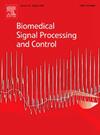An end-to-end deep learning framework for the automated diagnosis of OPLL in CT images
IF 4.9
2区 医学
Q1 ENGINEERING, BIOMEDICAL
引用次数: 0
Abstract
Accurate assessment of K-line status is vital for surgical planning and prognosis in patients with cervical Ossification of the Posterior Longitudinal Ligament (OPLL). However, variations in tissue appearance and morphological similarities between adjacent vertebrae in lateral cervical CT images complicate reliable edge identification for algorithms, posing challenges in recognizing easily confused vertebral landmarks. To address this issue, we propose an innovative approach that integrates K-line theory with deep learning techniques to evaluate K-line status efficiently and accurately in lateral cervical CT images of OPLL patients. Our method, the Dilated TransUNet, employs dilated convolution and Transformer modules to enhance the identification of easily confused vertebral landmarks, thereby improving detection accuracy. Additionally, we developed a discriminative algorithm utilizing dynamic thresholds for detailed pixel analysis around suspected ossification areas, effectively differentiating ossification from surrounding tissues. Experimental results demonstrate that our method achieves an average landmark detection accuracy of 98.49% and an image classification accuracy of 97.8%, both of which surpass existing methodologies. This framework reliably determines the position of ossification relative to the K-line, providing essential support for clinical surgical decision-making.
一种用于CT图像中OPLL自动诊断的端到端深度学习框架
准确评估k线状态对于后纵韧带颈椎骨化(OPLL)患者的手术计划和预后至关重要。然而,颈椎侧位CT图像中相邻椎骨的组织外观和形态相似性的变化使算法的可靠边缘识别复杂化,对识别容易混淆的椎体地标提出了挑战。为了解决这一问题,我们提出了一种将k线理论与深度学习技术相结合的创新方法,以有效准确地评估OPLL患者侧位颈椎CT图像中的k线状态。我们的方法,即Dilated TransUNet,采用了Dilated convolution和Transformer模块来增强对容易混淆的椎体标志的识别,从而提高了检测精度。此外,我们开发了一种判别算法,利用动态阈值对疑似骨化区域进行详细的像素分析,有效地将骨化与周围组织区分开来。实验结果表明,该方法的平均地标检测准确率为98.49%,图像分类准确率为97.8%,均优于现有方法。该框架可靠地确定相对于k线的骨化位置,为临床手术决策提供必要的支持。
本文章由计算机程序翻译,如有差异,请以英文原文为准。
求助全文
约1分钟内获得全文
求助全文
来源期刊

Biomedical Signal Processing and Control
工程技术-工程:生物医学
CiteScore
9.80
自引率
13.70%
发文量
822
审稿时长
4 months
期刊介绍:
Biomedical Signal Processing and Control aims to provide a cross-disciplinary international forum for the interchange of information on research in the measurement and analysis of signals and images in clinical medicine and the biological sciences. Emphasis is placed on contributions dealing with the practical, applications-led research on the use of methods and devices in clinical diagnosis, patient monitoring and management.
Biomedical Signal Processing and Control reflects the main areas in which these methods are being used and developed at the interface of both engineering and clinical science. The scope of the journal is defined to include relevant review papers, technical notes, short communications and letters. Tutorial papers and special issues will also be published.
 求助内容:
求助内容: 应助结果提醒方式:
应助结果提醒方式:


